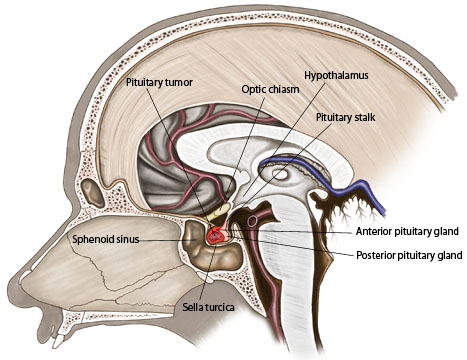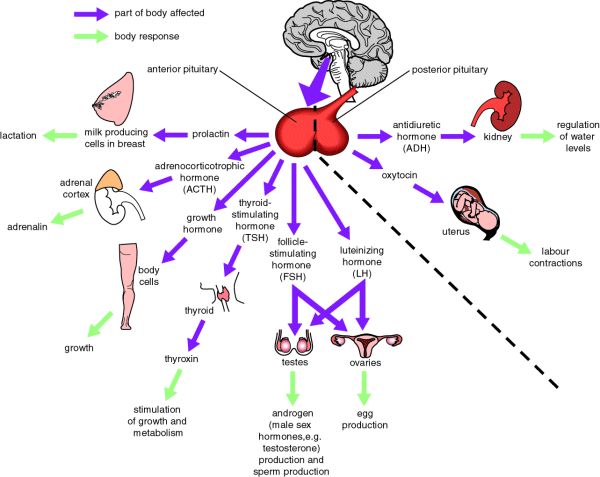THE PITUITARY GLAND
The pituitary gland, or hypophysis, is an endocrine gland about the size of a pea and weighing 0.5 grams (0.018 oz) in humans. It is a protrusion off the bottom of the hypothalamus at the base of the brain. The hypophysis rests upon the hypophysial fossa of the sphenoid bone in the center of the middle cranial fossa and is surrounded by a small bony cavity (sella turcica) covered by a dural fold (diaphragma sellae).

The anterior pituitary (or adenohypophysis) is a lobe of the gland that regulates several physiological processes (including stress, growth, reproduction, and lactation). The intermediate lobe synthesizes and secretes melanocyte-stimulating hormone. The posterior pituitary (or neurohypophysis) is a lobe of the gland that is functionally connected to the hypothalamus by the median eminence via a small tube called the pituitary stalk (also called the infundibular stalk or the infundibulum). Hormones secreted from the pituitary gland help control: growth, blood pressure, certain functions of the sex organs, thyroid glands and metabolism as well as some aspects of pregnancy, childbirth, nursing, water/salt concentration and the kidneys, temperature regulation and pain relief.
Some of the most relevant hormones produced by the pituitary gland are:
- prolactin, which stimulates milk production after pregnancy;
- ACTH (adrenocorticotrophic hormone) controls cortisol production by the adrenal glands;
- TSH (thyroid stimulating hormone) stimulates the thyroid gland to produce thyroid hormones;
- GH (growth hormone) is important for normal growth and bone development and for maintaining bone and muscle mass in adults.

THE PITUITARY TUMORS
Pituitary tumors can be either secretory (secreting excessive pituitary hormones) or non-functioning (non-secreting). Large tumors, whether secretory or non-functioning, can cause visual loss from pressure on the optic nerves or chiasm, headaches and/or hormone deficiencies from damage to the normal pituitary gland.
There are a number of syndromes associated with excess hormone secretion, including:
- Acromegaly
- Cushing’s Disease
- Prolactinoma
- TSH Adenomas
There are also a number of tumors, cysts and other disorders in the pituitary gland area that do not secrete hormones but may need to be treated. These include:
- Non-functioning pituitary adenomas
- Pituitary cysts (Rathke cleft cysts, arachnoid cysts)
- Craniopharyngiomas
- Inflammatory disorders (sarcoid, lymphocytic hypophysitis and others)
| Pituitary Adenomas | Craniopharyngiomas | Rathke Cysts | Other Rare Pituitary Diseases |
 English
English Italiano
Italiano